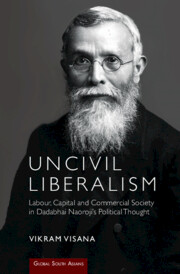Book contents
- Frontmatter
- Dedication
- Contents
- List of Abbreviations
- Acknowledgements
- Introduction
- 1 Sociality in an Imperial and Industrial Age
- 2 Sociality and the Parsis of Western India
- 3 Civil Society and Social Reform
- 4 Conceptualizing the Drain Theory
- 5 Making Commercial Society in India
- 6 Making Commercial Society in Britain
- 7 The Afterlives of Naoroji’s Political Thought
- Conclusion
- References
- Index
Introduction
Published online by Cambridge University Press: 27 September 2022
- Frontmatter
- Dedication
- Contents
- List of Abbreviations
- Acknowledgements
- Introduction
- 1 Sociality in an Imperial and Industrial Age
- 2 Sociality and the Parsis of Western India
- 3 Civil Society and Social Reform
- 4 Conceptualizing the Drain Theory
- 5 Making Commercial Society in India
- 6 Making Commercial Society in Britain
- 7 The Afterlives of Naoroji’s Political Thought
- Conclusion
- References
- Index
Summary
In the summer of 1893, a communal riot erupted between Bombay's Hindu and Muslim communities over the issue of cow protection. In the aftermath, the Pall Mall Gazette interviewed the member of parliament (MP) for Central Finsbury for his views. The representative of this London borough was the ‘Grand Old Man’ of India, Dadabhai Naoroji, who had been elected on the Liberal ticket the previous year and was immediately catapulted to global fame as the first Indian MP in British history. Already several decades into his peripatetic political career between India and Britain, Naoroji's insight into these riots was no doubt influenced by similar incidents that took place between his own Indian Zoroastrian community – the Parsis – and some of Bombay's Muslims in 1851 and 1874. He answered the reporter by claiming that fanatics of every religious creed caused civil strife in many societies. However, to his mind, the real question was why these riots were usually confined to what he dubbed ‘the lower orders’ and under what circumstances could diverse populations live together peacefully?
By this stage of his career, Naoroji had already formulated his iconic ‘drain theory’ of Indian poverty. Commonly understood as a critique of colonial economic extraction, the theory is widely regarded as an indigenous broadside against the political economy of empire and a formative step in theorizing Indian economic nationalism. This book contends that the retrospective reading of Naoroji's drain through the lens of anti-colonial nationalism has obscured the relevance of the theory's wider normative repertoire. By conducting a genealogy of Naoroji's thought, this book dramatically expands the political horizons of his drain theory from a local nationalist polemic to a global theory of sociality that took Britain's liberalism to task wherever it was applied. Put another way, Naoroji devised a materialist understanding of how individuals and communities from different cultural backgrounds could form bonds of social interdependence in a colonial age defined by doctrines of racial and cultural asymmetry. In using his drain theory to draw attention to British liberalism's inability to socialize all of its subjects into an imperial civil society, Naoroji offered his drain theory as a new paradigm to replace the empire's uncivil liberalism.
- Type
- Chapter
- Information
- Uncivil LiberalismLabour, Capital and Commercial Society in Dadabhai Naoroji's Political Thought, pp. 1 - 26Publisher: Cambridge University PressPrint publication year: 2022

